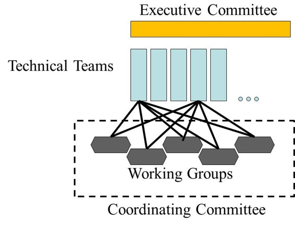Search QIN

About the Quantitative Imaging Network (QIN)
Network Structure

The organizational structure of the Quantitative Imaging Network is shown in the above diagram. The Executive Committee comprises of principal investigators from each research team and several program directors from the NCI Cancer Imaging Program. The Executive Committee has oversight of the network and actively meets by teleconference on a monthly basis. The EC establishes guidelines on network interactions with professional societies, methods for data sharing, publication and promotion material for the network, and the conduct of tool challenges, to name just a few.
From the outset of the network, it was recognized that while the individual teams each had specific aims to be reached in their research, there were a number of issues that were common to the network of teams. These include methods of harnessing informatics, interaction with clinical trial groups, data collection standardization and others. Rather than addressing these concerns individually, the network formed a number of working groups, each focused on a different issue. The members of the working groups are drawn from each of the research teams, making each working group a microcosm of the entire network. The current working groups are:
-
Clinical Trial Design & Development: The mission of the clinical trial design and development working group of the Quantitative Imaging Network (QIN) is to develop, validate and harmonize methods and tools for use of quantitative imaging in cancer clinical trials for outcome prediction and tumor response to therapy.
-
Bioinformatics and Data Sharing: The mission of the Bioinformatics Working Group (BIDS) is to define the informatics requirements common to all QIN centers and to establish consensus standards that are generalizable and useful to the quantitative imaging community nationally. Such requirements include specifying the breadth of imaging biomarkers assessed computationally and semantically, defining common data representation and exchange standards to promote cancer detection.
-
The MRI Working Group focuses on quantitative imaging challenges that confront the various forms of magnetic resonance imaging in the clinical setting. The working group coordinates challenges to test MR tools against clinical data. The mission of the MRI Working Group is to provide guidance, coordination, consensus building, and awareness regarding the development of MRI algorithms and methods for quantitative analysis of tumors, related tissues and organs, and changes in response to disease progression and treatment, as well as to influence the development of objective methods and metrics for assessment of image analysis accuracy, reproducibility, and robustness.
Cross-talk among the working groups is needed to ensure minimal duplication of effort and to transmit progress across the network. A Coordinating Committee consisting of the chairs and co-chairs of the various working groups meet monthly by teleconference to exchange progress and ideas.





